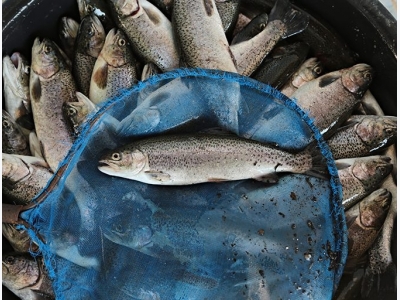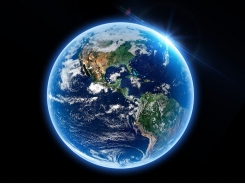Were no longer nomads, so we should farm more fish

Combing through history, seafood industry veteran. Phil Walsh combs finds no reason to restrict aquaculture
Shutterstock image. Photo by Kosin Sukham.
Around 12 thousand years ago a group of Homo sapiens departed Africa, where the species first appeared 150 thousand or so years earlier, and found their way to a region we now know as Iraq. Nomadic by necessity, early man sought a life devoid of the eternal hunt and constant threat of starvation. After centuries of working with wild beasts native to their new land, they settled on cattle, sheep and goats as their livestock of choice. All three formed herds, stayed close when given good pasture and were quick to forsake their savage ways.
In perhaps the greatest unintended consequence of all of history, taming wild animals and consequent ability to settle in one place allowed enough free time for writing, architecture, cities, civil process and metallurgy; in short, civilization.
Two thousand years later, following a century of experimentation with some of the 12 thousand species of grass in the world, early man chose to cultivate wheat, barley, rice and millet, because they grew fast, resisted blight, and were able to remain wholesome in long-term storage. Man remains drawn to open fields of grass to this day, particularly when it belongs to them, perhaps explaining why Americans spent $30 billion on their lawns last year, more than we did on foreign aid.
According to carbon-dated bone fish hooks (East Timor, 2011), man has been fishing for 42 thousand years. The gear – rope made of hemp and weirs formed from twigs and sticks – did little to deplete abundant fish stocks. That all changed in 1954, however, when British investors launched a 290-foot steel stern trawler designed to steam across the Atlantic to fish Canada’s Grand Banks.
Made ruthlessly efficient with technology spawned by World War II, the Fairtry used radar to fish around the clock in fog, sonar to sweep the sea for prey, monofilament nets made with DuPont Chemical’s monofilament line, hydraulics to manage the massive nets and mammoth harvests, mechanical knives to fillet fish in pitching seas, and Clarence Birdseye’s high-capacity plate freezer to put up and store the fruits of their labor. Provisioned for 70 days, she was back in 40, at capacity with 1.3 million pounds of fillets in her freezer, processed from the 4 million pounds of cod she’d caught in less than 30 days. A stunning success!
America can get serious about aquaculture, or bequeath near future generations with a world eerily similar to that of their ancestors, where their primary concern will be the source of their next meal.
With much of the world still suffering from a post-war protein shortage, it came as no surprise when a Soviet delegation approached the Fairtry investors with an order for 10 such ships, adding that copies of the builder’s plans were of course needed as well. Delighted, the owners surrendered the plans, and in less than a year there were two factory ships fishing the Grand Banks, identical in every way, save the hammer and sickle on the stack of the Pushkin, the Soviet Union’s first supertrawler. The ship order never materialized. The race was on, and in 1974 a thousand Soviet factory vessels caught 2,176,000 tons of fish worldwide, a harvest made all the more significant because it was made up of fish noticeably smaller than the those of earlier years. The 20-year harvest had far exceeded the fisheries’ maximum sustainable yield (MSY), a red line never to be crossed if a biomass is to remain sustainable.
America’s unilateral declaration of a 200-mile exclusive economic zone, or EEZ, in 1976 forced the distant water fleet to abandon North American fishing grounds. Cod, haddock, yellowtail flounder and ocean perch stocks began to recover. The trend was abruptly reversed when modernized, government-subsidized American and Canadian fishing fleets, armed with cold war technologies and limited only by quotas they set, finished what the foreign vessels had started. How bad did it get? In a land where children once scooped cod up with baskets, Canada declared a moratorium on cod fishing in 1992. The cod resource had shaped the culture of Canada’s maritime provinces for 500 years – and that fishery has yet to recover.
Man has been irresponsible with this precious resource, and new quotas and draconian restrictions on harvesting notwithstanding, the days of counting North American fisheries as a reliable source of affordable food are forever gone. Much hangs in the balance, and depends on what we do next.
Evolution ebbs and flows according to need. When mass starvation threatened post-war Europe, the American farmer maximized crop growth with genetically modified organisms, or GMOs, enabling the growth of sufficient amounts of wheat, grain and corn to avert disaster. Population growth and broad prosperity are now spiking consumption of protein, with broad analysis projecting near-term need as unable to be met by existing infrastructure. The need to innovate is upon us, the solution is clear, but muddled misconceptions and illogical legislation stand in the way.
Aquaculture stands alone as a producer of protein. Consider the superiority of finfish’s feed-conversion ratio over that of all other protein groups: 1 pound of feed produces roughly 1 pound of farmed salmon, while it takes 7 to 10 pounds of feed to make a pound of beef.
Then consider the deforestation, destruction of grasslands, exorbitant use of water and disposal of waste inherent to the cattle industry. Poultry’s better, but only when raised humanely, as this produces a superior tasting, healthier bird, but it falls short when comparing it to the variety, array of textures and tastes and infinite culinary applications of fish.
Recent innovations in aquaculture include the replacement of fishmeal and fish oil in aquafeeds with soybean and other plant products, closed-production systems that reuse water and prevent escapes, and the rearing of high demand, ocean-caught fish such as tuna, snapper, flounder and grouper.
Opposition to aquaculture centers on three premises. First, that our oceans be left alone; second, that farmed fish is raised in dirty water and is infused with antibiotics and other substances that promise harm to both the environment and those who eat the stuff; and third, that the escape of farmed fish into the wild will do nature’s gene pool irreparable harm.
Fish farmers explain that while it would be nice to leave our oceans undisturbed, hunger is a serious issue, and we need to grow food in them now, and rest assured that as little harm as possible will be inflicted on them, as all those privileged to spend a lot of time on the water share a deep respect for the world’s oceans.
As for drugs and dirty water, with the U.S. Food and Drug Administration never having reported a trace of antibiotics in farmed salmon, drugs don’t appear to be a problem. Dirty water … really? Ask anyone with an aquarium – fish don’t grow in dirty water, they die in it. Why on earth would anyone try to raise fish in dirty water? And while no one wants to see fish escape, particularly those who own them, it happens, but it’s rare – and we’ve yet to hear of any damage resulting from escapes. Take heart – closed systems that don’t allow escapes are being built now, and while their cost is higher, they’ll be located near population centers, promising to provide both jobs and food.
Consider these findings:
Out of a world population of 7 billion, 2 billion people suffer from some form of micronutrient deficiency. Source: IFPRI, Global Nutrition Report 2016
Poor nutrition causes nearly half (45 percent) of deaths in children under age 5 – 3.1 million children each year. Source: The Lancet, Series on Maternal and Child Nutrition, 2013
Hunger kills more people each year than AIDS, malaria and tuberculosis combined. Source: FAO, The State of Food Insecurity in the World 2015
Nearly three quarters of Earth’s surface is covered with water. While terrestrial protein production will forever suffer from restrictions imposed by the limited availability and suitability of land, aquaculture will suffer no such restraint, leaving it standing alone as the only logical solution to man’s impending nutritional needs. America can get serious about aquaculture, or bequeath near future generations with a world eerily similar to that of their ancestors, where their primary concern will be the source of their next meal.
Có thể bạn quan tâm
Phần mềm

Phối trộn thức ăn chăn nuôi

Pha dung dịch thủy canh

Định mức cho tôm ăn

Phối trộn phân bón NPK

Xác định tỷ lệ tôm sống

Chuyển đổi đơn vị phân bón

Xác định công suất sục khí

Chuyển đổi đơn vị tôm

Tính diện tích nhà kính

Tính thể tích ao hồ



 Telling aquaculture’s story, with every sale
Telling aquaculture’s story, with every sale  We can meet our planet’s protein needs with…
We can meet our planet’s protein needs with…